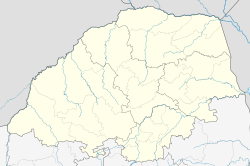Modimolle
Nylstroom | |
|---|---|
| Coordinates: 24°42′00″S 28°24′22″E / 24.70000°S 28.40611°E | |
| Country | South Africa |
| Province | Limpopo |
| District | Waterberg |
| Municipality | Modimolle–Mookgophong |
| Area | |
• Total | 74.9 km2 (28.9 sq mi) |
| Population (2011)[1] | |
• Total | 8,671 |
| • Density | 120/km2 (300/sq mi) |
| Racial makeup (2011) | |
| • Black African | 44.3% |
| • Coloured | 1.1% |
| • Indian/Asian | 0.7% |
| • White | 53.6% |
| • Other | 0.3% |
| First languages (2011) | |
| • Northern Sotho | 27.4% |
| • Afrikaans | 53.2% |
| • English | 4.1% |
| • Tsonga | 3.8% |
| • Other | 11.5% |
| Time zone | UTC+2 (SAST) |
| Postal code (street) | 0510 |
| PO box | 0510 |
| Area code | 014 |
Modimolle, also known as Nylstroom, is a town located near the southern edge of the Waterberg Massif in Limpopo province, South Africa. It is a medium-sized town that focuses primarily on agriculture and farming (citrus, grapes and cattle) as well as wildlife and tourism. Nylstroom is also located approximately 135 kilometres (84 miles) north of Pretoria, South Africa's capital city.
The Waterberg Biosphere spreading north, a UNESCO designated Biosphere Reserve, contains approximately 15,000 square kilometres (5,792 square miles). Waterberg is the first region in the northern part of South Africa to be named as a Biosphere Reserve by UNESCO. The extensive rock formation was shaped by hundreds of millions of years of riverine erosion to yield diverse bluff and butte landform.[2] The ecosystem can be characterised as a dry deciduous forest or Bushveld.


